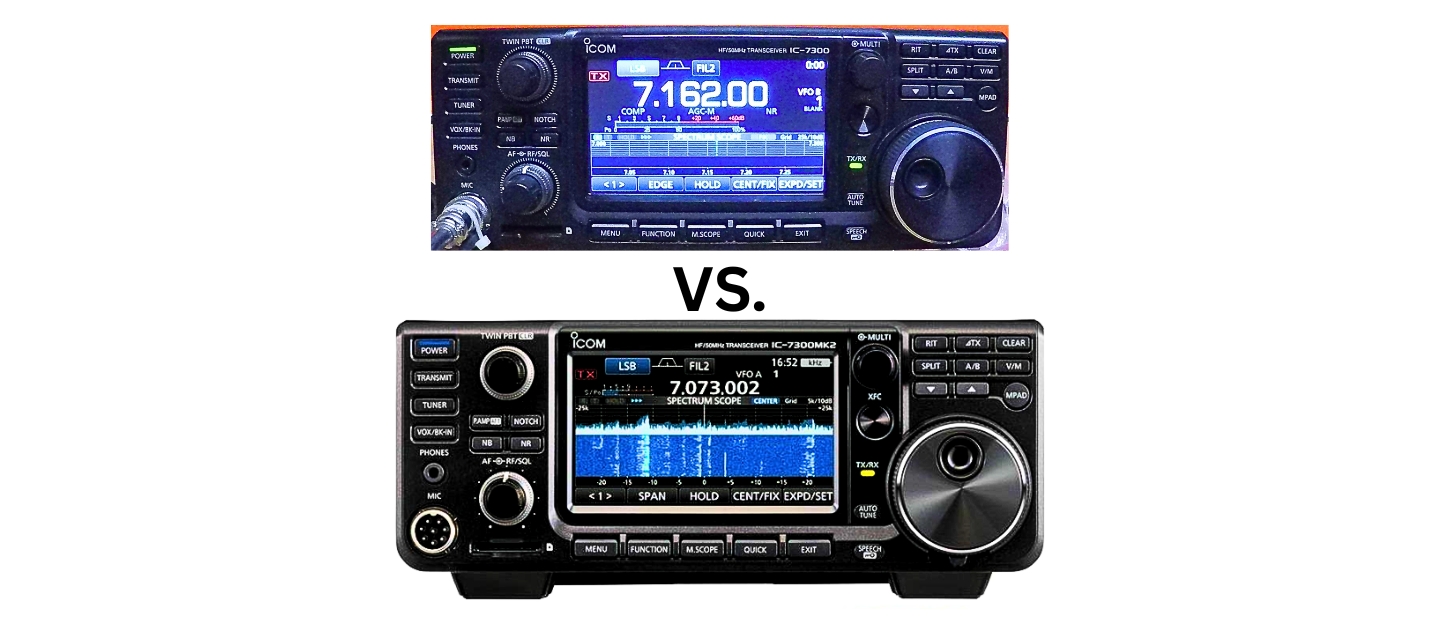Icom 7300 vs 7300MK2 is a common comparison for operators choosing a modern HF transceiver. The original IC-7300 set a high bar with its direct-sampling SDR architecture, and the MK2 refines that platform with incremental but meaningful updates.
Overall, both radios deliver excellent on-air performance for contesting, casual DXing, and ragchews, but the MK2 focuses on user-driven improvements. Consequently, choosing between them comes down to which refinements matter most to your operating style.
Performance Differences
The base receiver architecture remains direct-sampling SDR in both models, which preserves strong sensitivity and audio clarity. However, the MK2 typically shows slightly improved spurious signal handling and a marginally lower noise floor. Thanks to new firmware and front-end tuning.
In practice you will notice crisper audio and fewer artifacts when operating crowded bands,. Therefore the MK2 gives a small but useful advantage in challenging band conditions. Transmit performance remains excellent in both radios. Both deliver clean audio and reliable power output; nonetheless.
The MK2 sometimes includes optimized keying and ALC behaviors that tidy up voice peaks. If you push the radio into contests or high-duty-cycle work, the MK2’s thermal and power-management provides steadier performance.
Display and User Interface
Both radios use a large touchscreen that combines spectrum/waterfall with traditional control elements, making operation intuitive. Moreover, the MK2 refines the display software so menus feel slightly faster and more responsive. This speeds common tasks like filter selection and memory tuning.
The MK2 also improves contrast and touch responsiveness in some units, so operators working outdoors or with gloves may prefer it. Still, the original IC-7300‘s screen remains highly functional, and many users find no practical difference in day-to-day use.
Filters, DSP, and Signal Processing
Icom equipped both models with powerful DSP that handles AGC, noise reduction, and automatic notch features well. Additionally, the MK2 often ships with updated DSP profiles and extra selectable filter shapes that make narrow CW and crowded SSB work cleaner.
Therefore. you can tighten your receive bandwidth without losing immediately useful audio, and this helps with close-in interference. Both radios support multiple IF filter settings and software-defined roofing filters that reduce overload on strong-signal environments.
However, the MK2’s firmware tweaks improve filter switching speed and reduce transient noise when changing settings.
Features and Modes
Both radios support the full set of HF/50 MHz modes, RTTY and PSK via soundcard interfaces, and convenient USB audio/CI-V control. Furthermore, the MK2 commonly introduces minor firmware-driven features such as expanded memory handling, quicker band stacking register recall, and more flexible CW keyer options.
If digital-mode integration matters, both radios work well with modern digital suites, and therefore you’ll face no compatibility issues. The MK2 also tends to receive periodic feature additions sooner, because Icom used the MK2 release to incorporate community-requested improvements.
Accessories and Expandability
Standard accessories like external antenna tuners, genuine Icom filters, and external speakers plug into both radios without issue. Moreover, the MK2 sometimes ships bundled with updated manuals or accessory recommendations that reflect newer third-party cable pinouts.
Both radios accept the same microphone and external keyer accessories, and thus your existing add-ons will usually remain compatible. If you plan to use optional front-panel upgrades or external pan adapters, check vendor notes because a few niche accessories may require firmware-specific settings that the MK2 handles more gracefully.
Practical Considerations and Use Cases
If you already own an IC-7300, upgrading to an MK2 yields modest but tangible gains in user experience and marginal performance under heavy-signal conditions. On the other hand, a new buyer choosing between the two should weigh price and availability.
The MK2 typically commands a premium, therefore you get the latest firmware baseline and reduced need for immediate updates. For contesters and DXers who operate long sessions, the MK2’s refinements in stability and filter behavior can add up to more effective operating time.
Conversely, casual operators and newcomers will find the original IC-7300 more than capable and often available at a lower cost.
Final Thoughts On Icom 7300 vs 7300MK2
The Icom 7300 vs 7300MK2, they both remain excellent choices for modern HF enthusiasts, and each retains the clean SDR sound and usability that made the platform popular.
Ultimately, the MK2 polishes the original, adding firmware, UI, and filtering refinements so buy the MK2 if you want the newest steady-state experience. However, if budget and value carry more weight, the original IC-7300 continues to deliver exceptional performance and widespread accessory compatibility.
Please consider Donating to help support this channel
